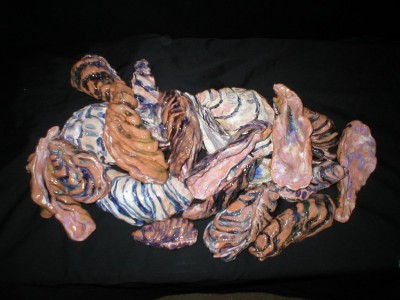
Through art, Art Sphere Inc. uses the themes of oysters and water to teach the importance of the conservation of wildlife habitats. Unique artwork shown locally and abroad represents the joint efforts of artists and community members, who use printmaking, drawing, sculpting, and painting methods as well as mythology, poetry, and metaphor to explore the symbol of water. This is seen in art by various cultures. The sculptures above are 3-foot ripped paper community-made sculptures and below are clay oysters.

Mussels and oysters are amazing creatures that consume the pollution from water, which purifies our drinking water system, prevents erosion by connecting to other oysters, and creates healthy habitats for animals to thrive.
Having provided a sustainable food supply and contributed to the local economy of Pennsylvania, Delaware, and New Jersey communities for centuries, many communities along both sides of the Delaware River have a long history of depending on oysters. The local Indigenous Peoples in the Americas tribe called the Lenape, lived by nearby streams, lakes, and rivers where they gathered and ate freshwater mussels. Clams, oysters, and scallops were also gathered from the ocean shore and bays. During periodic migrations to the coast, the Lenape gathered and ate shellfish, principally clams and oysters found in the Delaware River and its tributaries.
Connect with others in history and be creative now! Can you think of some expressions with oyster references? How about: “The world is your oyster.” The proverb first appears in Shakespeare’s play, The Merry Wives of Windsor (1602). What does that expression mean to you? How might you interpret that idea in a drawing?
See Lesson Plans on the theme of oysters at:
Learn more about the history of the oyster at:
Additional resources on water/oyster issues today can be found at:

